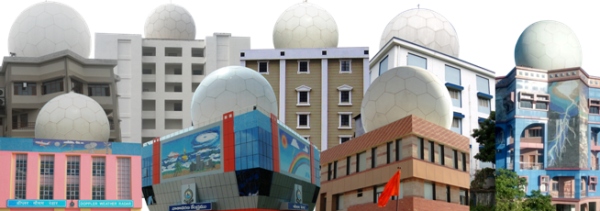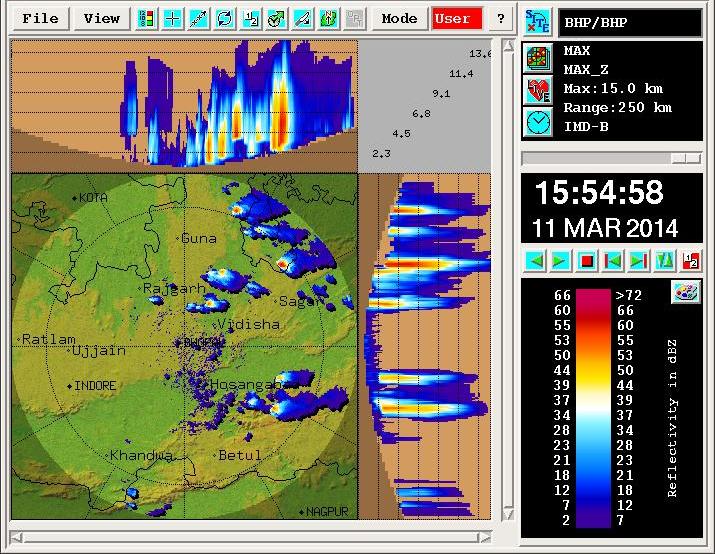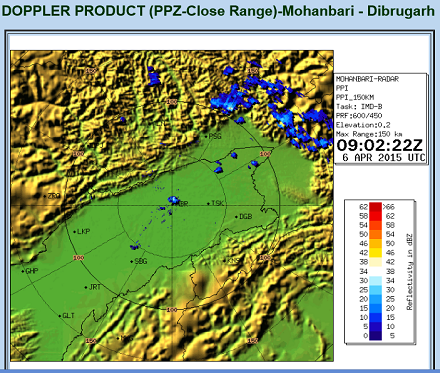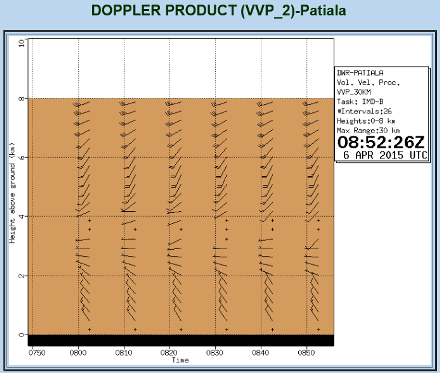
Doppler Weather Radars (S, C and X Band)
Weather Radars are the basic and most important tool for a Meteorologist for Nowcasting and Forecasting
of various severe weather events. We at SGS Weather are executing the network of 12 numbers S Band Metstar WSR-98D with Vaisala signal processor
and IRIS application software in India. The WSR-98D combines state-of-the-art technologies with proven off-the-shelf components to create a system
that is reliable and easy to operate. In addition to its very attractive up-front cost, WSR-98D is also extremely cost-efficient to maintain. S band
radars operate on a wavelength of 8-15 cm and a frequency of 2-4 GHz. Because of the wavelength and frequency, S band radars are not easily attenuated.
This makes them useful for near and far range weather observation. The size of the Antenna is 8.5 meters and it requires a large motor to power it.
The installation includes provision for transfer / networking of digital radar data and networking of existing DWR and future DWR installation for
generation of composite mosaic image at a centralized location.
The lists of sites installed are:

- New Delhi
- Hyderabad
- Nagpur
- Agartala
- Patna
- Lucknow
- Patiala
- Mohanbari
- Bhopal
- Karaikal
- Paradeep and Goa are under installation
Weather radars detect the motion of rain droplets in addition to the intensity of the precipitation. Data is analyzed to determine the structure of storms, wind pattern and their potential to cause severe weather. It is used to locate precipitation, calculate its motion, and estimate its type (rain, snow, hail etc.).
Dual polarization weather radars are the standard for modern radar systems, producing clear, clutter-free, high-resolution measurements
of rainfall events.
They provide precise quantitative precipitation estimation (QPE) to help meteorologists gather rainfall accumulation
measurements. This helps to clearly distinguish between different types of precipitation and improve data quality by eliminating moving,
non-meteorological targets.
Doppler Weather Radar Products can be used for the following applications

- Weather surveillance
- Severe weather monitoring
- Hurricane, typhoon, and cyclone tracking
- Hail detection
- Hydrometeorological applications, such as flood forecasting
- Airport wind-shear detection
- Meteorological research
- Weather modification
- Agriculture
- Radiosonde Launch support systems
We also sell and maintain X and C Band Radars
X band radars operate on a wavelength of 2.5-4 cm and a frequency of 8-12 GHz. Because of the smaller wavelength, the X band radar is more sensitive
and can detect smaller particles. These radars are used for studies on cloud development because they can detect the tiny water particles and also used
to detect light precipitation such as snow. X band radars also attenuate very easily, so they are used for only very short range weather observation. Also,
due to the small size of the radar, it can therefore be portable like the Doppler on Wheels.
C band radars operate on a wavelength of 4-8 cm and a frequency of 4-8 GHz. Because of the wavelength and frequency, the dish size does not need to be very large. The signal is more easily attenuated, so this type of radar is best used for short range weather observation. The frequency allows C band radars to create a narrow beam width using a smaller dish. C band radars also do not require as much power as S band radar
 Radar 1
Radar 1
 Radar 2
Radar 2
We install C Band Radars. Weather radars are flexible and easy to use, with the most comprehensive and robust software in the industry – perfect
for fast processing and sophisticated clutter filtering. Vaisala Sigmet Digital Receiver and Signal Processor RVP900 and Interactive Radar Information System IRIS
deliver the world’s most sophisticated application software and signal processing. The systems can be accessed from anywhere via a secure network link, while the
integrated Uninterruptible Power Supply (UPS) ensures continuous operation during temporary power outages. The Radar Antenna Controller provides complete fail-safe
operation to protect the antenna and pedestal structure from operating outside its limits. All parts can be accessed without the need to dismount the antenna or
pedestal, making routine maintenance easier and faster. IRIS™ has the most comprehensive suite of products available in the industry.
The product configuration and product scheduler menus give operators full control over the details of the product generation and the mix of products for each operational
mode. All products are made in the original polar coordinates of the radar data with correction for earth curvature and full interpolation.
See Also in Our Key Solutions








